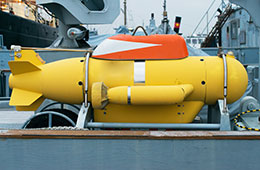 These unmanned marine vehicles have played a valuable role in commercial, research, environmental protection, military/defense, search and salvage applications. The increasing demand for lightweight, heavyweight and large vehicles has helped address the need for advanced processing capabilities and the evolving market requirements. Master Bond adhesives, sealants, coatings has been in the forefront of these efforts. Our products for autonomous underwater vehicles are durable, resilient, possess high bond strength to multiple substrates such as high strength steel, magnesium alloys, aluminum alloys, titanium alloys, carbon fiber reinforced plastics under hostile saltwater environments. This includes underwater pressure at significant depths and resistance to corrosion. Additionally these formulations withstand low temperatures, and provide water tight seals for crucial electronic packaging. Special grades are also designed to deliver heat dissipation characteristics to guard sensitive sophisticated electronic components against excess heat.
These unmanned marine vehicles have played a valuable role in commercial, research, environmental protection, military/defense, search and salvage applications. The increasing demand for lightweight, heavyweight and large vehicles has helped address the need for advanced processing capabilities and the evolving market requirements. Master Bond adhesives, sealants, coatings has been in the forefront of these efforts. Our products for autonomous underwater vehicles are durable, resilient, possess high bond strength to multiple substrates such as high strength steel, magnesium alloys, aluminum alloys, titanium alloys, carbon fiber reinforced plastics under hostile saltwater environments. This includes underwater pressure at significant depths and resistance to corrosion. Additionally these formulations withstand low temperatures, and provide water tight seals for crucial electronic packaging. Special grades are also designed to deliver heat dissipation characteristics to guard sensitive sophisticated electronic components against excess heat.
Much research and development remain to be done and are underway on technological improvements in autonomy, energy management, navigation, sensor systems, 3D imaging, communications. Most noteworthy are efforts to produce new smaller, more intelligent, quicker, ruggedized, lower power, more reliable sensors and optical acoustic higher resolution imaging systems. Attempts to implement a communication network for multiple vehicles is also under investigation. Fuel cell technology would be a major boost and most desirable in solving the necessity for increasing long term endurance missions.
The following impressive tasks have been achieved by autonomous underwater vehicles:
- pipeline inspection
- detail map of sea floor
- oceanographic research
- identify hazards to geologic formations
- measure the absorption or reflection of light
- characterize chemical or biological properties of water
- intelligence, surveillance, reconnaissance for military/defense
- commercial exploration
- navigation and accident investigation
- debris removal
- marine archeology
- ports and harbor monitoring
- hydrographic survey
- marine geology
- 3D water-current profiling
